How to Build a Survival Shelter

Being a “survivor” has captured the imagination of millions of TV watchers. But a survivor is much more than a TV fantasy. A survivor is someone prepared to live—and live as healthfully as possible—when life far from home doesn’t go exactly as planned.
Being prepared to survive in the outdoors starts with knowing what to be prepared for. You can live days without water and weeks without food. People who don’t survive in the outdoors most often die from losing their body heat, not necessarily from starvation or dehydration. You need to be able to start a fire. And perhaps most importantly, you need to be able to build a shelter to stave off wind, rain and snow, and to keep your body heat trapped where it belongs: near your body.
Here are the keys to taking shelter in the wilderness:
DRESS WISELY
Your first line of defense against the elements is the “shelter” you choose to wear. If you wear layers of synthetic material or wool, and carry a shell of windproof, waterproof material, you are ready for anything. You’ll trap your body heat instead of expending it on the outside world.
THE RIGHT SPOT
Choosing the best place to build a survival shelter is important. It should be in the driest spot you can find. Nothing sucks out body heat faster than wetness. If it isn’t too cold, build a shelter on high ground. Breezes will help keep the bugs away, and you’ll be easier to see if a search party passes nearby. If a cold wind is blowing, choose a spot sheltered by trees. But don’t build in the bottom of deep valleys or ravines where cold air settles at night.
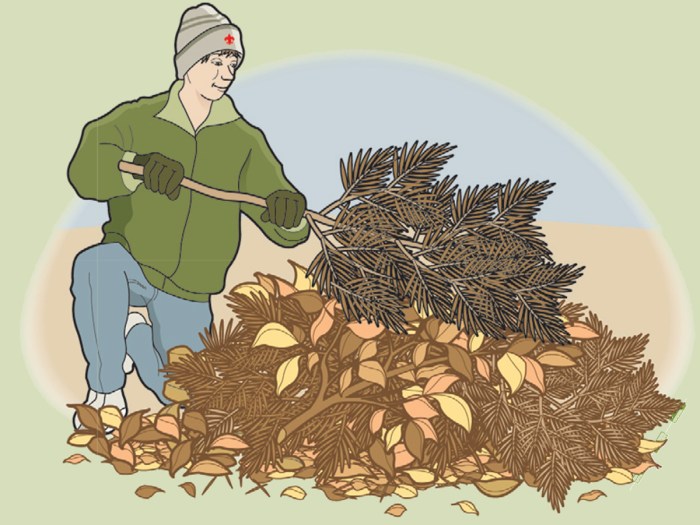
THE COCOON
If it’s almost dark and you can hurriedly collect dry debris (leaves, pine needles, bark) from the forest floor, make a pile two or three feet high and longer than you are tall. When you burrow into the pile, you are in a natural sleeping bag that protects against heat loss.
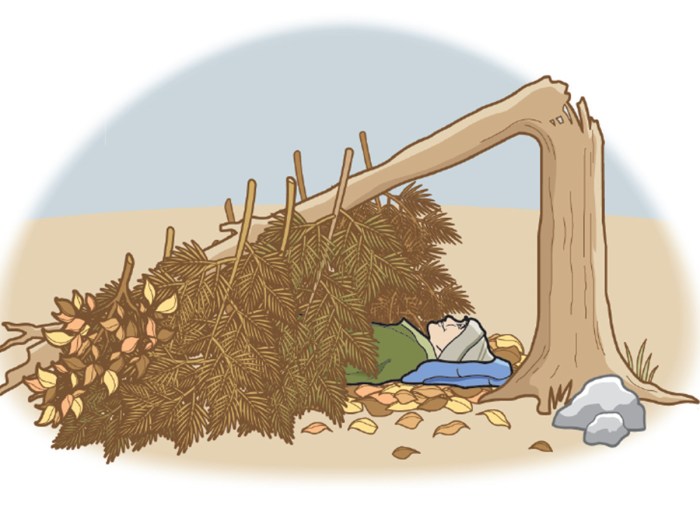
THE FALLEN TREE
The simplest shelter is a fallen tree that has enough room under it for you to crawl in. Lean branches against the windward side of the tree (so the wind is blowing into it and not against it) to make a wall. Make the wall thick enough to keep out wind. If you can build a fire on the open side of your shelter, the heat will help keep you warm.
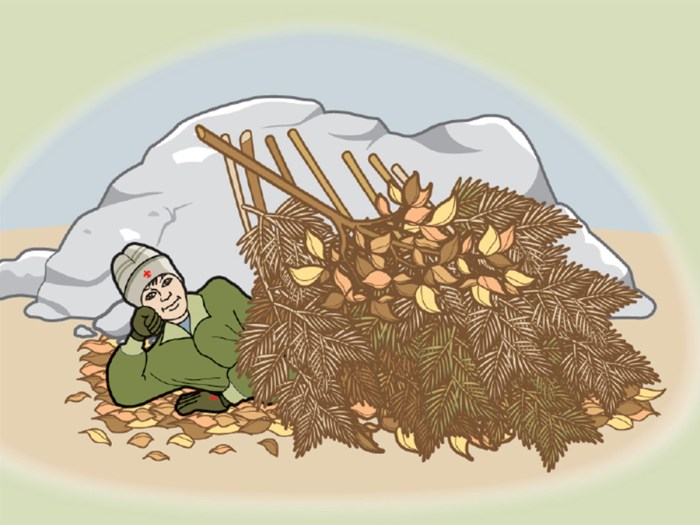
THE LEAN-TO
If you find a fallen tree without enough room under it, or a rock or a small overhang, you can build a simple lean-to. Start by leaning fallen limbs against the object, such as the top edge of an overhang, to create a wall. Lean the limbs at an angle to help shield rain. Cover the leaning limbs with leaves, boughs, pine needles, bark or whatever the forest offers. When you have built a thick wall, you can crawl underneath into your shelter. Remember to make your shelter no bigger than you need to fit you and anybody else with you. The bigger the space, the harder it is to keep warm.
You can also build a lean-to by placing one end of a long stick across a low limb of a tree and propping up the other end of the stick with two more sticks. Tie the ends of the sticks together with your boot laces or belt. Lean more sticks against the horizontal stick. Then pile leaves and other forest debris against the leaning sticks until you have a wall. Once again, a fire on the open side of the lean-to will add much heat to your “room.”
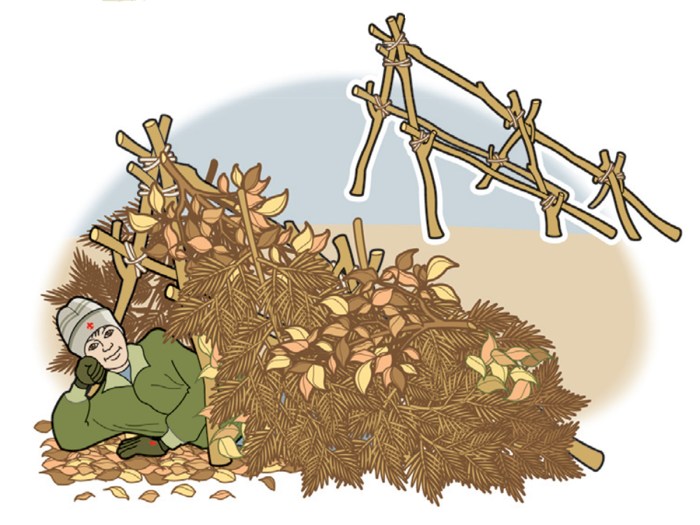
THE A-FRAME
If you can’t make a lean-to, you can make an A-frame shelter. You’ll need two sticks four or five feet long and one stick 10 to 12 feet long. Prop the two shorter sticks up in the shape of the letter A. Prop the longer stick up at the top of the A. Tie the three sticks together where they meet. The three sticks will be in the shape of an A-frame tent with one end collapsed against the ground. Now prop up more sticks against the longer stick, and pile forest debris against the sticks until you have an insulated shelter open at the high end.
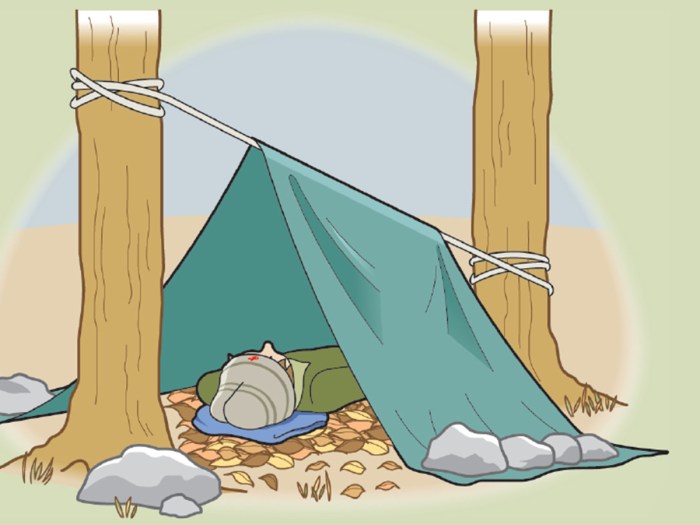
A TARP
When you have a tarp, sheet of plastic or Space Blanket with you, and some rope or cord, tie a line between two trees. Tie it low to the ground with just enough room for you to lie beneath. Stretch the tarp over the line. Place large rocks or logs on the ends of the tarp to hold it in place with the edges close to the ground. If it’s snowing, tie the line off higher on the trees. Steeper walls will shed snow better. Now you have an emergency tent.
YOUR BED
Your shelter is not complete until you have made a bed to lie in. Dry leaves work well. Make your bed a little bigger than the space your body covers and at least eight inches thick. When you snuggle into it, you are ready for the unexpected night out.
BAD PLACES TO BUILD A SHELTER
1. Anywhere the ground is damp.
2. On mountaintops and open ridges where you are exposed to cold wind.
3. In the bottom of narrow valleys where cold collects at night.
4. Ravines or washes where water runs when it rains.
Whare do u get it
What is in a standared boyscout backpack?
what kind of knife do you need and what is required?
I took the wilderness suvival merit badge and it was awesone, but i was really cold
Sweet. I am taking wilderness survival at summer camp. These will skills will come in handy.
PEOPLE THIS AWESOME, NOW I NOW EXACTLY WHAT BUILD WHEN I AM LOST IN A FOREST, DESSERT, etc
are you sure you can survive in the desert it’s one of the crueler places to survive in. I personally know that since the sonoran desert is my backyard in arizona. at a 120 degrees and up…..
i will use this for my wilderness survial merit badge at camp bartlett
i really lov these shelters i want to try them sometime thanks Boy’s Life! 🙂
i learned a lot
REALY COOL! i agree with M j 12 thanks for the facts!
I like the A-frame the best and the tarp the least because it would be heavy to carry.
coooooooool. i want to try it
thanks good article
hey that is very cool :>)
AWESOMME!! Now IF I get lost I know what to do if It’s dark and I’m lost. 🙂
This is great suggistions when making a sheler for the surivial merit bage.
great stuff
cant wait to make a A-Frame. its goin to be kewl. I wonder how the cocoon can keep you warm? Now I can get the wilderness survival badge a lot easier. Thanks Boys Life!!
i have made most of them they are all good shelters
thats pretty kool, i just got my wild survival badge and i regret now visiting the website sooner =(
Cool! Maybe I’ll try to make an A-frame shelter in my backyard!
P.S. What is a multytool?
cool!!!
I pult a lean to to finish my wilderness sunvile merit bage.also a pocketknife or a multytool [my favorte] canhelp you out a lot.
I made one one time, by taking a skinny log and putting in the fork in a tree and the othe end laying on the ground. Then I leaned smallsticks against it. Then i covered it in moss.
I love the lean too!
hey I have a question what should you do (shelter wise) if there was thunder and litening and or hail? how would i take cover?
nice love the artical
I took a class on this type of stuff in high school. Big rocks make a fast shelter make sure if it’s raining the water running down the rock has some were to go other then under you!! lean the wood against it to make a lean to. the best shelter is a fast one.. try to cover it with hemlock, pine branches, leaves, mud, dirt, grass, and even small sticks what ever is on hand at a moments notice. It’s Imperative to stay dry in any life threating wilderness emergence, do what ever is necessary to do so. small Fires help a lot.
this was great now I know how to survive if I get lost in the woods
this was a cool article i enjoyed the pictures somthing else i wanted to add when on a beach for a shelter run a trench pointing toward the ocean or else wind will blow right through (i experienced the ‘wind tunnell effect before not pleasnt’)
im going 2 make one of these tomorrow!
i tried off a broken stranded car
You know one thing I learned in my years of scouts was always have a pocketknife and a roll of twine you never know what kind of situation you will find yourself in. Like the scout motto says “Be Prepared!”
Try to build a shelter against
a huge tree!
great article
get however many u need 2 cover ur body
This was a great article, but it left me with one question: About how many pine branches do you need for the fallen tree shelter?? I am doing a report at school on shelters, and it is great EXCEPT for the fact that people will be wondering the same thing I was. If anyone has an answer, I’d like to hear it!!!!!
this advice was sooooo useful when we went to winter survivail camp our scout master siad we should get an award
i never knew that
cool i will do it
~Great ideas and now when I go hiking, I will know even more about building a shelter.~
~ Thank You!!!!!~
Cool now I want to get lost so I can build a shelter!
This is a very informational piece and it will help you figure out what to make for a shelter.
cool i shood try to get lost sometime for kicks
A good thing to do is have every scout carry a space blanket in their pocket.
Natural caves and hollow logs work well as shelter. Just be careful to ensure that no critters live in them.
That waa great I have a campout for boy scoutts soon and I’am just joining and for 1 badge we have to build our shelter and now I know 5 ways and good and bad places to camp.
this information was very useful to me when I was lost for 1 night in the woods.
Very informative! It contains information that everyone should know especially any scout. These shelters very clever. Anyone should at some time in their life build and live one of these shelters. I will make these shelters for kicks when I can’t find a tent buddy.
Awesome! Great article. Building some of these shelters will be a good activity for the Webelos in our pack.